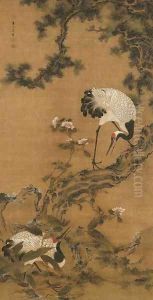Wu Huan Paintings
Wu Huan was a Chinese painter during the Ming Dynasty, whose life details are not extensively documented, making his biography somewhat elusive. Born in 1435, the specific details of his death remain unknown, reflecting the scant historical records on many artists of his time. Despite the limited information, Wu Huan is recognized for his contributions to Chinese landscape painting, a genre that flourished during the Ming Dynasty.
Wu Huan's artistic style is characterized by its adherence to the traditions of Chinese landscape art, incorporating the use of brush and ink to create scenes that capture the ethereal beauty of nature. His works are noted for their delicate brushwork and attention to detail, embodying the classical Chinese philosophy of harmony between humans and nature.
During his lifetime, Wu Huan was part of a rich cultural milieu that valued the arts, literature, and scholarship. The Ming Dynasty (1368–1644) was a period of cultural resurgence in China, with significant achievements in various fields, including literature, philosophy, and the visual arts. Artists like Wu Huan contributed to this vibrant cultural landscape, although the specific contributions of many artists from this period are less documented than those of their counterparts in other eras.
Wu Huan's legacy, like that of many artists of his era, is preserved through the works he left behind and the influence he had on subsequent generations of Chinese artists. His paintings, though not extensively cataloged or studied as those of some other Ming Dynasty artists, continue to be appreciated for their aesthetic value and historical significance.
In sum, Wu Huan's life and work exemplify the rich tradition of Chinese landscape painting during the Ming Dynasty. Despite the lack of extensive records about his life and death, his contribution to the arts remains a testament to the enduring legacy of Ming Dynasty painters.












